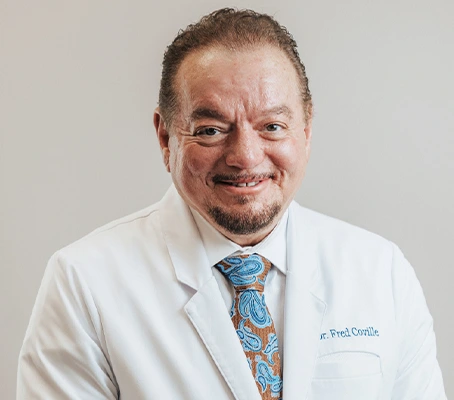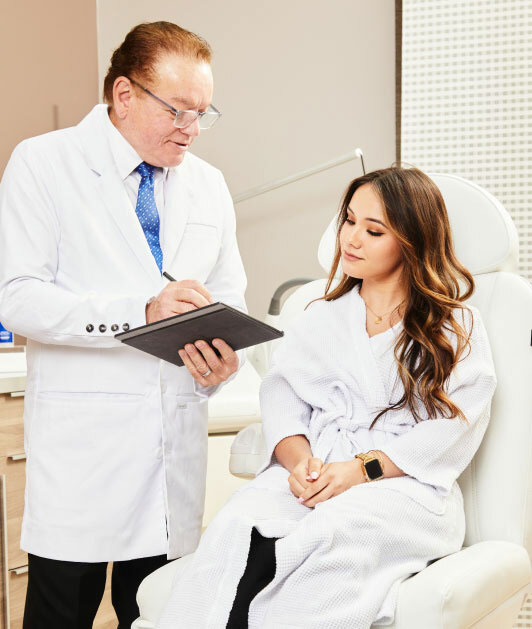- Select Language ▼
Cornerstone Plastic Surgery has partnered with Rejuvenessence to bring you an expert-led Weight Loss Program. Learn More on our partner’s website!
While younger faces benefit from evenly distributed fat across the face, many areas begin to lose volume over time. We used to think all facial aging was due to skin sagging. Now we understand one of the most important reasons your face will begin to look older—age-related volume loss. All those animated expressions we make while talking, laughing, eating, and crying wear down the tissues of our faces. We lose a good deal of facial fat and even bone as we age. In effect, our faces deflate more than they sag as we mature.
Dr. Fred Coville has been restoring facial volume through fat transfer and repositioning facial structures for many years, and he was one of the early adopters of these techniques. As an expert in facial rejuvenation, Dr. Coville uses your own fat to restore and optimize your facial structure, bringing back that youthful, healthy, and energetic face of your younger years.
Facial rejuvenation procedures revitalize your face by increasing the volume of your features. Facial fat transfers are a safe and effective procedure to fill out the face using your body’s own fat. Dr. Frederick A. Coville has been performing fat transfer procedures for over 20 years. His decades of experience assure every fat grafting procedure performed in Cornerstone’s New Jersey facility has ideal final results.
Fat transfer procedures involve removing fat from a donor site—such as the abdomen or inner thighs—and redistributing it to an area lacking volume. These procedures enhance areas across the body, including the buttocks, cheeks, and breasts. Much like synthetic fillers or implants, facial fat transfers augment the treated site to provide a fuller, more youthful appearance.
Facial fat transfers, also known as facial fat injections or facial fat grafting, primarily focus on injections to the cheeks, lips, jawline, and the area around the eyes. They provide natural-looking results using only a little amount of expertly distributed fat.
During the procedure, living fat cells are removed from your donor site and injected into areas that lack volume. While a portion of the cells transferred die and are reabsorbed by the body, those that survive reintegrate into the tissues and act like normal fat cells in their new location.
Fat can be injected wherever it’s needed to provide a fuller, rejuvenated look. Every face is unique, and facial fat injections can be customized to suit your specific needs.
Fat can be injected across the face to provide different effects by improving volume in the targeted areas. It can be used to:
Fat injections can also be performed in multiple locations across the face, such as the temples and jawline, for facial contouring.
Certain chronic health issues or poor physical health could lead to risks both during and following the procedure. To pursue any cosmetic surgery, it’s better to be in good overall physical health.
Before undergoing a facial fat transfer, patients should strive to attain a stable weight they’ll be able to maintain in the future. This ensures the recovery process will go smoothly and your results will remain ideal over time. In order to perform the procedure, patients must first have enough body fat to harvest safely. If not, it will be impossible to perform the transplant.
In short, a patient must meet the following minimum criteria in order to pursue facial fat grafting:

While the technical skills of your injector are crucial for determining the final results, much also depends on your adherence to post-procedure instructions.
Prior to your procedure, you will undergo a consultation session in our New Jersey office, where you’ll have the opportunity to meet our team and ask any questions about the process. Together with Dr. Coville, you can explore your treatment options and begin to draft your customized facial fat grafting procedure.
It is important to groom the area where fat will be harvested 24 hours prior to your procedure. If you’re prone to cold sore flare-ups, medication may need to be applied to the treatment areas prior to the procedure.
Upon arriving at our Atlantic County facility, a local anesthetic will be applied to the donor site and treatment area. Oral sedatives and nitrous oxide gas are also available if needed. While patients are typically awake during facial fat transfers, traditional anesthesia can be used upon request in our outpatient surgery center. You can speak with Dr. Coville about your anesthetic preferences during your initial consultation.
Dr. Coville will begin your facial fat transfer by harvesting a small amount of fat from your donor site. Depending on the amount of fat you have and your specific preferences, the inner thighs, inner knees, lower abdomen, or flanks make good donor sites for the fat to be transferred. The fat is then cleaned using a specialized process known as decanting and centrifugation to remove damaged fat cells unlikely to survive the grafting process. The remaining whole cells are then ready for reinjection.
During the third and final step of the process, fat cells are injected into the targeted areas. To ensure a higher fat survival rate, small droplets of fat are slowly injected into the subcutaneous tissue, the innermost layer of skin.
Successful facial fat transfers rely on a combination of technical skills that take years to perfect. The talent and expertise of your injector directly impacts your final results, which is why every facial fat transfer performed at Cornerstone is carried out by Dr. Coville himself. He has extensive experience performing fat transfer procedures gleaned from his world travels and working with talented, innovative cosmetic surgeons throughout his career. His skill and training have helped innumerable patients achieve stunning improvements in facial volume and contouring.
The recovery process following a fat transfer procedure typically requires 7-10 days of rest at home. For a portion of this time, you will need to minimize your movement and rest in bed. Place an extra pillow behind you while you sleep to keep your head elevated.
During the recovery process, avoid applying pressure to the area where fat has been injected, as this can damage fat cells and impact your final results.
Bruising and swelling are typical parts of the recovery process, and while they may last for as long as one month, both typically subside within a few days. Applying cold compresses to the treated area will help reduce any swelling or discomfort. You may also need to take medication to manage your pain.
Most patients return to work after 2 weeks of recovery with little to no sign of the procedure being performed. Final results can take up to 6 months to become fully apparent.
While final results are visible 3-6 months after the procedure, noticeable results should slowly begin to appear as swelling subsides during the first 10 days of recovery. As the healing process progresses, you should notice changes in your face, particularly around the treatment site, including:
Unlike synthetic facial fillers, which last for 6-18 months, the results of facial fat transfers last indefinitely. Fat that survives the grafting process reintegrates with the blood supply and tissues as if it had been there all along.
Written By: Dr. Frederick Coville
Frederick A. Coville, M.D., Cornerstone Plastic Surgery’s Owner and Medical Director
Frederick A. Coville, M.D., Cornerstone Plastic Surgery’s Owner and Medical Director, has been an Aesthetic and Reconstructive Plastic Surgeon for over 25 years. He firmly believes each of us possesses an inner “Foundational Beauty.”
As a student of beauty all his life, he calls upon his naturally artistic eye and God-given talents as a surgeon to deliver the results you demand. Dr. Fred likes to say, “It’s my job to help you find Your Beautiful!”
Request your consultation and let
us create a custom experience for you
